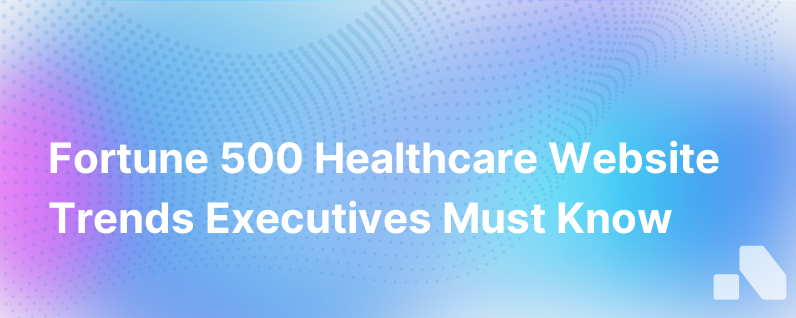
As the world increasingly becomes digital-centric due to technological advancements and the recent pandemic's aftermath, Fortune 500 healthcare companies have a unique opportunity to elevate their online presence. A well-optimized website can generate leads, drive patient engagement, and solidify branding. A robust online presence can also enable these companies to shape the sentiment around healthcare provisions, particularly when technology is accelerating the convergence of health and digital.
Let's look at five key trends that are shaping Fortune 500 healthcare websites in today's digital landscape.
Going Beyond Static Websites to Digital Health Hubs
The traditional healthcare website model, primarily used to disseminate information, is undergoing a shift. Now, these sites are emerging as ‘digital health hubs’, offering a more comprehensive array of services. They've become platforms for conducting operations - scheduling appointments, accessing records, providing telehealth services, and even real-time consultations.
Fortune 500 healthcare companies are tapping into these capabilities to improve patient experiences and ultimately, their bottom line. The transformation into digital health hubs offers patients and visitors a more seamless user experience, streamlining medical practices and patient management for healthcare providers.
Prioritization of User Experience (UX)
UX is no longer an optional aspect of web design - it’s a necessity. In today's digital age, the capability to provide a smooth and easy user experience can significantly reduce bounce rates, increase engagement, and drive conversions.
Fortune 500 Healthcare companies are progressively acknowledging that offering clear navigation, easy-to-access content, fast loading times, and an intuitively designed website is critical. Furthermore, these companies are incorporating accessible designs that cater to every user, thus ensuring that no one is left out.
These trends indicate a shift from a solely provider-focused architecture to a patient-centric framework.
Multi-Device and Mobile-First Approach
As smartphones continue to dominate as a primary internet access point, healthcare companies need to ensure their websites aren’t just mobile-friendly, but mobile-first. A mobile-first approach isn’t about making your site merely responsive, but about prioritizing a seamless mobile experience during the entirety of the designing process.
Many Fortune 500 healthcare companies are now using Accelerated Mobile Pages (AMP) to deliver high-speed mobile experiences, recognizing that a quick mobile experience is more than just a convenience - it’s an expectation.
Secure Patient Portals
Demonstrating a commitment to privacy is paramount for medical websites. As healthcare moves towards individualized care, personalized patient portals have become a trend. A super-secure online portal can allow patients to access digital health tools, manage appointments, renew prescriptions, view personal health information, and communicate with health care providers.
Furthermore, as cyber threats continue to rise, the implementation of SSL, HIPAA-compliant servers, and GDPR compliance features convey trustworthiness to visitors, while also emphasizing the company’s dedication towards ensuring confidentiality and privacy.
Integrating Artificial Intelligence (AI)
AI has decisively entered the healthcare landscape and Fortune 500 healthcare companies are leveraging this powerful technology to drive engagement and improve site functionality. From virtual assistants to chatbots to dynamic content optimization to ultra-personalized user experiences, AI integration has enhanced the user journey by adding a layer of interactivity and personalization.
These automated platforms can provide immediate responses to general queries, direct users to the appropriate resource, freeing up human resources, and ensuring round-the-clock customer service.
Integrating AI has also enabled these websites to offer predictive analysis, providing insights about various diseases, symptoms, and health conditions based on the user’s inputs and past data.
Conclusion
The blending of healthcare and digital has sculpted a new frontier for Fortune 500 companies. In this constantly changing digital landscape, an agile approach is crucial to capitalize on emerging trends and meet users' evolving demands.
As these trends continue to evolve, Fortune 500 healthcare companies must continue to incorporate technologies like AI, adhere to a mobile-first web design philosophy, create robust digital health hubs while maintaining a safe ecosystem for patients and maintaining optimal UX.
One of the tools they can leverage to ensure a competitive edge and constantly stay tuned with the shifting landscape is Aomni. This AI platform provides real-time account research, competitive insights, and personalized sales content in less than 15 minutes. With such technologies at their disposal, Fortune 500 healthcare companies are well-equipped to navigate these exciting times in the healthcare industry's digital evolution.